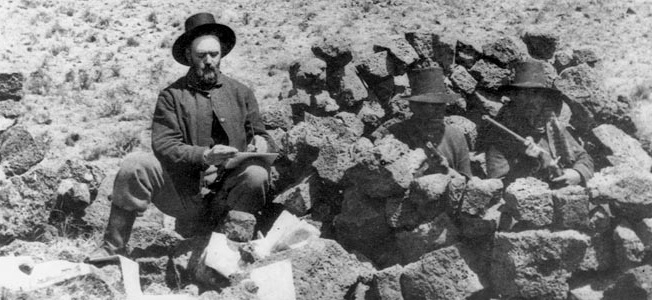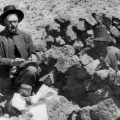
( – promoted by navajo)
The Modoc homeland is the Tule Lake area on the border between California and Oregon. In 1873, the U.S. Army engaged a small band of Modoc under the leadership of Captain Jack in what has been called the Modoc War. There were many things which lead up to this war, including governmental intolerance of Indian cultures, particularly Indian religions.
In 1864, Elijah Steele negotiated a treaty with the Modoc in which the United States agrees to obtain a reservation for the Modoc along Lost River. However, the government did not submit the treaty to the Senate for confirmation as it had not been authorized by the Bureau of Indian Affairs. The Modoc felt that the government had unilaterally cancelled their treaty.
Following the cancelled treaty, the U.S. government held a treaty council with the Klamath, Modoc, and Yahuskin (a Shoshone band affiliated with the Paiute) at Council Grove, Oregon. The government proposed that the three groups share a reservation in eastern Oregon. The Modoc were less than enthusiastic about this treaty as it meant moving away from their traditional territory. However, they felt that they had little choice, so they signed the treaty.
In the treaty, the American government agreed to pay annuities and to pay for reservation improvements. The government, however, also reserved the right to place other tribes on the reservation.
In 1865, Captain Jack (Kintpuash) led the Lost River Modoc off the Klamath Reservation because the superintendent of Indian affairs refused to recognize him as chief. Four years later, he moved back to the Klamath Reservation. He brought with him 43 men, women, and children.
In 1870, Captain Jack led a larger group of 371 of his people off the Klamath Reservation and returned to the Modoc homeland. Once back in the Modoc homeland, Captain Jack steadfastly refused to budge.
In 1871, Captain Jack killed an Indian doctor for failing to cure one of his children-an action which was acceptable in Modoc culture. The Indian agent, however, ordered the military to arrest him for murder. Captain Jack, alerted that the army was going to arrest him, hid in the mountains and avoided capture.
After returning to the Klamath reservation briefly, Captain Jack once again left the reservation with a group of about 50 Modoc. At this time, one of the primary functions of the reservation was to convert Indians to Christianity. In doing this, all traditional Indian religious practices, including shamanism, were not allowed. Being upset at not being able to practice their traditional ways, the Modoc intended to return to their homelands in the Tule Lake area of Northern California.
Orders were then issued to the 1st Cavalry to compel the Modoc, by force if necessary, to return to the Klamath Reservation. The troops arrived at the Modoc camp at daybreak, taking the Indians by surprise. The orders of the Indian superintendent to return to the reservation were explained to them. The interpreter realized that the Modoc were not going to comply and notified the army officer. The troops then fired several volleys into the tipis.
The Indians took refuge in the lava beds near Tule Lake, California. The lava beds are a maze of twisted stone, hidden caves, lava flows, and natural trenches. The Indians killed 12 settlers on their flight south.
The spiritual leader of the group was Curley Headed Doctor. In the lava beds, he had a rope of tule reeds woven, dyed red, and stretched around the campsite. He claimed that no American soldier could cross this rope. Since no soldiers cross this rope during the conflict, the Modoc assumed that it worked.
In 1873, a peace commission met with Captain Jack. The area of conflict was clear: the army wanted Captain Jack’s band removed to the Klamath reservation, while Captain Jack wanted a reservation set aside for his band on their ancestral lands.
While the truce between the army and the Modoc called for no hostile movements during the peace negotiations, the army moved its soldiers and canons forward in violation of the truce. In desperation, the Modoc made plans to kill General E.R.S. Canby, the army field commander. While Canby was warned of the plans by an interpreter, he insisted that the Modoc would not dare to carry it out with so many soldiers around. However, the Modoc carried out their plans and General E.R.S. Canby and the Reverend Eleazer Thomas were killed. The Indian agent, Alfred B. Meacham, was wounded. This intensified the Modoc War in which Captain Jack’s 50 Modoc warriors eluded 1,000 pursuing soldiers for a month.
From an Army perspective the Modoc War was fought by an inexperienced army of poorly trained and poorly supported soldiers led by incompetent officers. The Modoc, on the other hand, were led by Captain Jack who proved to be a fine military strategist and tactician.
In one encounter, the 400 soldiers who were sent in to subdue the Modoc encountered a thick fog and soon retreated in panic and disarray. From the Modoc perspective, Curley Headed Doctor’s medicine had worked. He had brought a fog to confuse the enemy, and then he turned the soldiers’ bullets so that no Modoc was hurt.
In another instance, a large patrol blundered into a carefully planned ambush. The army and the press labeled this a massacre. The soldiers had left on the maneuver as though they were going to a picnic rather than a battle. One of the Modoc leaders, Scarface Charley, had called down to some of the survivors: “We don’t want to kill you all in one day” and through this generosity several soldiers escaped.
In one incident, the army soldiers found an old woman-described as being 80 or 90 years old-in the rocks near the stronghold. The lieutenant asked: “is there anyone here who will put that old hag out of the way?” A soldier then placed his carbine to her head and shot her. One of the witnesses to the event, Maurice Fitzgerald, later wrote:
“This incident goes to show that humanity is about the same the world over and not to any great extent affected by religion, language, or national boundaries.”
Captain Jack finally surrendered and in the peace negotiations, he told the Americans:
“This is my home; I was born here, always lived here, and I don’t want to leave here.”
The captured Modoc were then marched under heavy guard to Fort Klamath, a military post near the Klamath Reservation. Thirteen of the warriors are locked in cells in the guardhouse. The other 140 men, women, and children are confined to a stockade that measures 150 feet by 50 feet.
One group of 17 Modoc men, women, and children peacefully surrendered to the army. They were loaded into a large wagon and transported toward the Klamath Reservation without a military escort. The wagon was stopped by the Oregon Volunteers. A little later, masked men approached the stopped wagons and killed four of the captive Modoc men and wounded a Modoc woman. The army made no effort to catch the killers.
Following the Modoc War, 153 Modoc were shipped from the Klamath Reservation in Oregon to the Quapaw Agency in Oklahoma. The Modoc were sent to Oklahoma as prisoners of war.
The commission investigating the Modoc War reported:
“The causes leading to war were the dissatisfaction of Captain Jack’s band of Modocs with the provisions and execution of the treaty of October 1864 and refusal to abide thereby” and “The immediate cause of hostilities was resistance by the Indians to military coercion.”
The Modoc War cost the lives of about 200 American soldiers and volunteer militia. Only 13 Modoc were killed.

Leave a Reply